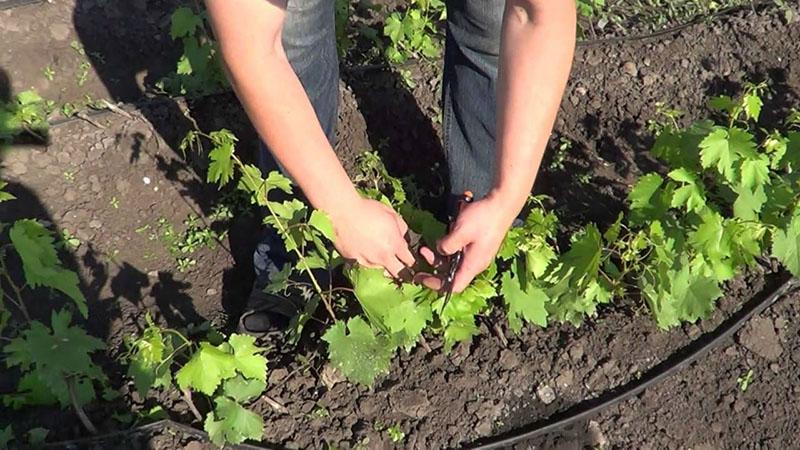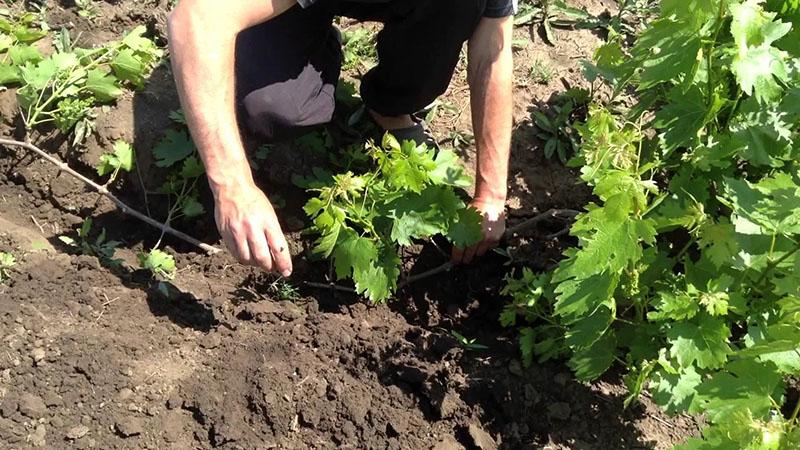How to propagate grapes - characteristics and description of methods
 To expand the vineyard area, as well as replace or restore old plants, it is necessary to increase the number of existing bushes. There are several ways to propagate grapes. Some of them are laborious and ineffective, others are time-tested and give excellent results.
To expand the vineyard area, as well as replace or restore old plants, it is necessary to increase the number of existing bushes. There are several ways to propagate grapes. Some of them are laborious and ineffective, others are time-tested and give excellent results.
How to propagate grapes in simple and affordable ways

There are several ways to grow grapes:
- layering (vine);
- cuttings - elongated or unrooted shanks;
- seeds.
If reproduction is carried out in the spring with the help of cuttings or cuttings, then grapes grows from one shoot, retaining the qualities of the plant from which the planting material was taken.
For the propagation of grapes in the northern regions of Russia, cuttings are the best option.
Layers (vine)
 In order to quickly rejuvenate the plants and increase the number of bushes, the vine is dropped. Otherwise, this method is called grape propagation by layering.
In order to quickly rejuvenate the plants and increase the number of bushes, the vine is dropped. Otherwise, this method is called grape propagation by layering.
Layers are ideal for areas where there are no diseases of the plant root system. In this case, even difficult-to-root varieties will take root perfectly.
The advantages of the technique:
- revival of old plants;
- the possibility of obtaining young seedlings;
- distribution of grapes on the site;
- can be used for landscape design, as it helps to grow bushes of an unusual shape;
- the characteristics of the mother plant are fully preserved;
- fast survival rate;
- the possibility of obtaining a harvest already in the first year of cultivation.
Layers lead to depletion of the parent bush.
Work with layering is carried out in early spring, before the buds swell, as well as in winter and autumn. You will need to dig out grooves, approximately 0.5 m wide, leading from the parent plant to the place where you plan to grow the new bush.
The slope of the deflected vine is approximately 40-45 degrees relative to the mother bush. Nutritious, loose soil is best, and the vine itself must be healthy and strong.
How deep to make the grooves depends on the evenness of the area - the smoother the surface, the shallower the depth (0.4-0.5 m). On a steep slope - 0.8 m, in the foothills - 0.6 m.
The vine needs to be bent at the base, correctly at the bottom of the dug groove, the grape stem is horizontal.
To accelerate the development of the root system, it is better to remove excess buds that are on the vine before the bend. You should also remove the leaves and eyes on the deepened segment. It is necessary to leave 3 or 4 leaves (eyes) only on the top of the vine brought out to the outside.
The stem laid in the groove must be covered with earth, lightly tamped with your feet and watered (you will need from 2 to 4 buckets of water).
A mixture of a bucket of humus with 200 g superphosphate, poured into a groove and mixed with soil (for this it will need to be dug up) will increase the rate of root formation and provide good yields on young plants.
Vine propagation of grapes is done in several ways:
- dry shoots;
- air layering;
- green shoots;
- short layering;
- kataviak (also called katavlak).
Layering dry shoots
 Such a cut is called dry, because an already lignified vine is used. In late autumn, when the growing season ends or in early spring, the shoot, which is located close to the surface of the ground, fits into the dug groove. How this is done can be seen in the picture.
Such a cut is called dry, because an already lignified vine is used. In late autumn, when the growing season ends or in early spring, the shoot, which is located close to the surface of the ground, fits into the dug groove. How this is done can be seen in the picture.
In the autumn cut, the top of the shoot with eyes is covered with soil for the winter. The height of the formed mound should be 25-30 cm.
 In the first year, this cut gives a maximum of 4 shoots with a small yield. In the second year of life, a new bush with a higher yield is formed. The growing shoots receive food from the parent plant and from their roots simultaneously. Therefore, a new bush can be formed by pruning for 2-3 years.
In the first year, this cut gives a maximum of 4 shoots with a small yield. In the second year of life, a new bush with a higher yield is formed. The growing shoots receive food from the parent plant and from their roots simultaneously. Therefore, a new bush can be formed by pruning for 2-3 years.
How to propagate grapes by air layering
 The technique allows you to form new roots on a lignified vine. In the spring, all leaves must be removed from a strong shoot. At 20 cm from the top, the bark is cut in the form of a ring, the width of which is approximately 0.5 cm. The cut site is wrapped with moistened moss and covered with black polyethylene (film). In the place of the incision, roots grow after a while.
The technique allows you to form new roots on a lignified vine. In the spring, all leaves must be removed from a strong shoot. At 20 cm from the top, the bark is cut in the form of a ring, the width of which is approximately 0.5 cm. The cut site is wrapped with moistened moss and covered with black polyethylene (film). In the place of the incision, roots grow after a while.
 In the fall, the vine with the formed root system must be cut and planted in a pot in a dark, cool room. In the spring, when it gets warmer (the temperature should be stably positive), young seedlings are transferred to open soil.
In the fall, the vine with the formed root system must be cut and planted in a pot in a dark, cool room. In the spring, when it gets warmer (the temperature should be stably positive), young seedlings are transferred to open soil.
Short layering
 The method is suitable for propagation of grapes in the summer months. In the same year, in the fall, there will be a harvest on such shoots.
The method is suitable for propagation of grapes in the summer months. In the same year, in the fall, there will be a harvest on such shoots.
Next to the mother bush, a dimple 5 cm deep is dug, well watered. Part of the vine is placed in it. An approximately 15-centimeter shoot tip remains on the surface. Then the hole is filled up and compacted.
A support for tying the vine should be installed near the top.
Green shoots
 The method is used if you need to grow grapes in a certain place, since the used long shoots make it possible to "reach" the desired place.
The method is used if you need to grow grapes in a certain place, since the used long shoots make it possible to "reach" the desired place.
At the base of the parent plant in the spring, it is necessary to leave several shoots for layering. The procedure is carried out in summer, when the green vine is one and a half to two meters long.
The essence of the method:
- A groove 0.3 m deep is dug from the base of the mother bush. The length should coincide with the length of the vine.
- Fertilizer mixed with the soil is placed at the bottom of the groove, and a shoot is placed on top.
- The laid vine must be attached to the ground in several places with staples in the shape of the letter "P". The groove is covered with a 10-15 cm layer of soil, which is slightly compacted and watered abundantly with water.
- A 20-30 cm top of the vine should remain on the surface, which is tied to the support. In the future, a new bush will grow from it.
To stimulate the formation of roots, it is necessary to tie the layering vine with wire at the base of the parent bush. Over time, the shoot will become thicker and the wire will pinch the conductive system, thereby limiting the supply of nutrients from the mother plant.
 Green cuttings form a root system faster than dry shoots, since shoots are used that have not yet grown to the length required for laying.
Green cuttings form a root system faster than dry shoots, since shoots are used that have not yet grown to the length required for laying.
Kataviak (katavlak)
 This technique is suitable if you need to restore a vineyard consisting of old plants or to transfer bushes to another place. In this case, the layering of the whole bush is made.
This technique is suitable if you need to restore a vineyard consisting of old plants or to transfer bushes to another place. In this case, the layering of the whole bush is made.
If you carry out katavlak in the fall, then the resulting bushes will be more viable and productive.
The method is not widely used due to the complexity and laboriousness of the work.
Layering has several advantages over other grape propagation methods:
- The roots and the aerial part of the plant are better developed than propagation by cuttings. More active growth occurs due to better nutrition, which comes simultaneously from the mother plant and its own roots.
- You can get both a new bush and move an old plant to another place.
- It is better to root grape cuttings in spring; Chinese cuttings can be done in spring, summer and autumn.
How to propagate grapes by cuttings
 The best time for harvesting cuttings is autumn, since by this time the vines accumulate maximum nutrients. Thanks to this, cuttings take root faster than seedlings that were harvested in spring.
The best time for harvesting cuttings is autumn, since by this time the vines accumulate maximum nutrients. Thanks to this, cuttings take root faster than seedlings that were harvested in spring.
Cuttings stored in the refrigerator must be wrapped in polyethylene. This will help to retain moisture - the air in the refrigerator dries out. Without a film, the planting material will die.
Advantages of grape propagation by cuttings:
- The opportunity to get a lot of healthy planting material for free for growing varieties with good yields.
- It does not matter what the weather will be during the cuttings harvesting period.
- Such planting material can be sold, transported or sent by mail.
- A large amount of planting material does not take up much space.
- When propagating by cuttings, you can control the process of formation of the root system and the growth of plants.
- It will not be difficult to treat such seedlings from pests and diseases.
- Absolutely any variety can be propagated by cuttings.
 Cutting as a method of growing grapes is most often used in the northern regions of the Russian Federation, where summer is short, sunny days are few and frosts are often observed.
Cutting as a method of growing grapes is most often used in the northern regions of the Russian Federation, where summer is short, sunny days are few and frosts are often observed.
The need and timing of germination of cuttings
 Before planting the shanks, they must be germinated. This will ensure a strong, healthy bush that is resistant to disease.
Before planting the shanks, they must be germinated. This will ensure a strong, healthy bush that is resistant to disease.
For the full formation of the root system of a seedling, at least 2 months are required, therefore, in different regions of Russia, germination must be started at different times:
- in the south of the Russian Federation - end of January, first half of February;
- in the Middle Lane and the Moscow region - late February or early March;
- in the conditions of Siberia and the Urals - the second half of March.
Sprouted cuttings can only be transplanted into permanent soil, heated to +10 degrees Celsius.
If there is a threat of frost, then sprouted cuttings planted in a permanent place will need to be covered.
The most favorable period for the germination of shanks is the period of forced dormancy in grapes, which falls on the last days of January. The vine is already ready for the beginning of the growing season, but low temperatures do not allow buds to bloom.
How to plant grapes with cuttings in winter:
- From the end of November to the end of December, cuttings 10-15 cm long should be cut from annual shoots with a diameter of at least 0.8 cm (each of them should have 2 eyes) and put in water for about 24 hours to soak.
- After that, it is necessary to process the shanks with a weak solution of potassium permanganate and put them for storage in a refrigerator or a box with sand (the temperature should not be higher than +15 degrees Celsius, otherwise the roots will start growing earlier than necessary).
- A month or a month and a half before planting, the cuttings will need to be taken out for germination, having previously rejected and thrown away the spoiled ones (with traces of mold, darkened, with dark spots).
Stages of germination of cuttings
 In order for the root system to form strong and healthy, before germination, the vine should be placed in a rich pink solution of potassium permanganate for 30 minutes, and then rinsed with running water. Then the cut points are updated - a new cut is made.
In order for the root system to form strong and healthy, before germination, the vine should be placed in a rich pink solution of potassium permanganate for 30 minutes, and then rinsed with running water. Then the cut points are updated - a new cut is made.
The next step is soaking. The shanks are placed in settled water for 48 hours (the water must completely cover them).
After soaking, the cuttings must be removed from the water and made with a sharp knife in the lower part of each on the bark longitudinal scratches - this will increase the number of roots forming.
 The simplest way of germination is in water, the temperature of which is +24 degrees. In this case, the air should be colder, approximately +8 ... +13 degrees.Light is not required to form the root system.
The simplest way of germination is in water, the temperature of which is +24 degrees. In this case, the air should be colder, approximately +8 ... +13 degrees.Light is not required to form the root system.
The roots will appear in 20-30 days, when they are 2-3 cm long, the cuttings must be transplanted into the ground.
Using seeds
 During propagation, the characteristics of the parent plant of the variety are not preserved. For this reason, gardeners rarely propagate grapes by seed. Only if it is necessary to develop a new variety or variety of grapes that are difficult to root.
During propagation, the characteristics of the parent plant of the variety are not preserved. For this reason, gardeners rarely propagate grapes by seed. Only if it is necessary to develop a new variety or variety of grapes that are difficult to root.
Useful Tips

When self-propagating grapes, points should be taken into account:
- The cuttings must be checked by making a fresh cut. The appearance of droplets at the cut means that the shanks are suitable for seating.
- Cuttings with dark spots are not suitable for propagation. In a good shank, the cut must be green and no other.
- The use of growth stimulants when germinating cuttings will accelerate the formation of the root system.
- The soil for planting young seedlings should be light and rich in nutrients.
- Layers need regular watering (no more than 1 time every 10 days), weed control and loosening of the soil.
The most effective methods are considered to be propagation by cuttings and vines (layering). To carry out rooting of cuttings, you need to know how to plant a branch of grapes correctly.
When propagating by layering, 100% survival rate of young shoots is observed, since in the first year they simultaneously receive nutrients from the parent plant and from their own roots.
If you plan to grow a large number of planting material or increase the number of varieties cultivated on the site, then cuttings are best suited. If it is necessary to expand the territory of the vineyard of an existing variety, the optimal propagation option is layering.